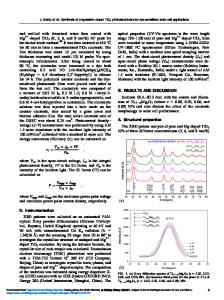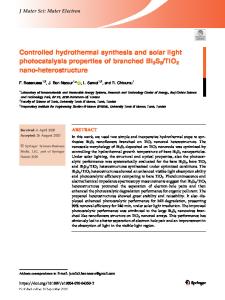Solvothermal synthesis of a highly branched Ta-doped TiO 2
- PDF / 364,618 Bytes
- 7 Pages / 584.957 x 782.986 pts Page_size
- 15 Downloads / 348 Views
Dongsheng Li and Nichola Kinsinger Department of Chemical and Environmental Engineering, University of California Riverside, Riverside, California 92521
Francisco Zaera Department of Chemistry, University of California Riverside, Riverside, California 92521
David Kisailusa) Materials Science and Engineering Program, University of California Riverside, Riverside, California 92521; and Department of Chemical and Environmental Engineering, University of California Riverside, Riverside, California 92521 (Received 17 May 2011; accepted 12 August 2011)
We present a low-temperature, hydrothermal synthesis method for Ta-doped TiO2. Here, alkoxide-based precursors are mixed at low temperatures to suppress differential hydrolysis and phase separation. This method ensures homogeneous, molecular mixing of the Ta dopant with the native oxide up to a concentration of ;2.5 at.%. X-ray diffraction and energy dispersive spectrometer analyses confirm a uniformly doped rutile TiO2. Scanning electron microscopy and transmission electron microscopy analyses reveal a highly branched structure. Optoelectronic properties of these structures were investigated using ultraviolet-visible spectroscopy and low-temperature photoluminescence.
I. INTRODUCTION
Titanium dioxide (TiO2) is an inexpensive, chemically stable and nontoxic metal oxide that has been widely used as an advanced semiconductor and as a white pigment for many years.1–3 TiO2 has generated much interest for photoelectrochemical applications, such as photocatalytic water4 and air purification and water splitting for hydrogen fuel generation, first reported by Fujishima and Honda.5,6 Photoelectrolysis of water can be used as a renewable and environmentally benign route for hydrogen generation. Both applications require a photogeneration of electronhole pairs that are involved in subsequent chemical reactions. Photoexcitation of a semiconductor-like TiO2 requires light with the energy equivalent to the band gap. The band gap energy of TiO2 in two of its phases (i.e., anatase and rutile) falls within the ultraviolet (UV) spectrum (i.e., 3.0 eV for rutile and 3.2 eV for anatase).7 Hence, TiO2 is an active photocatalytic material within the UV spectrum and absorbs only the UV part of solar spectrum. Engineering TiO2 (size, phase, and band gap) for enhanced photocatalytic response and visible-light photogeneration has been investigated for decades. Modification a)
Address all correspondence to this author. e-mail: [email protected] DOI: 10.1557/jmr.2011.286 J. Mater. Res., Vol. 26, No. 20, Oct 28, 2011
http://journals.cambridge.org
Downloaded: 10 Feb 2015
of TiO2 through transition metal or anion doping has proven to be one of the most promising methods to modify the band structure.8–12 Doped TiO2 has been studied from both experimental and theoretical aspects. Various transition metals have been used to substitute for Ti in TiO2 including Fe, V, W, Cr, Co, and Mn.9–11,13–15 For example, it was found that both V9 and Mn13 atoms can substitute for Ti atoms within the TiO2 lattice,
Data Loading...











